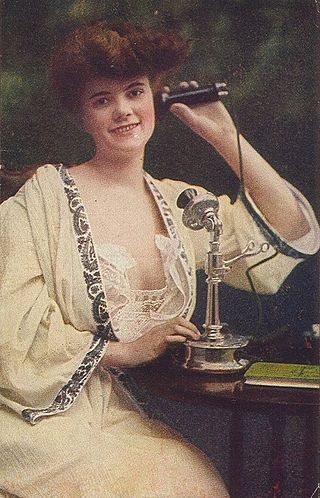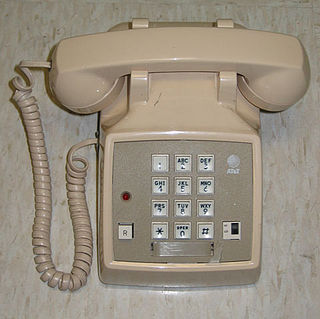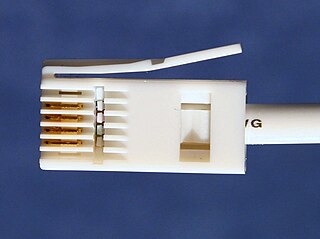
A telephone is a telecommunications device that permits two or more users to conduct a conversation when they are too far apart to be easily heard directly. A telephone converts sound, typically and most efficiently the human voice, into electronic signals that are transmitted via cables and other communication channels to another telephone which reproduces the sound to the receiving user. The term is derived from Greek: τῆλε and φωνή, together meaning distant voice. A common short form of the term is phone, which came into use early in the telephone's history.
In telephony, on-hook and off-hook are two states of a communication circuit. On subscriber telephones the states are produced by placing the handset onto or off the hookswitch. Placing the circuit into the off-hook state is also called seizing the line. Off-hook originally referred to the condition that prevailed when telephones had a separate earpiece (receiver), which hung from its switchhook until the user initiated a telephone call by removing it. When off hook the weight of the receiver no longer depresses the spring-loaded switchhook, thereby connecting the instrument to the telephone line.
A dial tone is a telephony signal sent by a telephone exchange or private branch exchange (PBX) to a terminating device, such as a telephone, when an off-hook condition is detected. It indicates that the exchange is working and is ready to initiate a telephone call. The tone stops when the first dialed digit is recognized. If no digits are forthcoming, the partial dial procedure is invoked, often eliciting a special information tone and an intercept message, followed by the off-hook tone, requiring the caller to hang up and redial.

A blue box is an electronic device that produces tones used to generate the in-band signaling tones formerly used within the North American long-distance telephone network to send line status and called number information over voice circuits. This allowed an illicit user, referred to as a "phreaker", to place long-distance calls, without using the network's user facilities, that would be billed to another number or dismissed entirely as an incomplete call. A number of similar "color boxes" were also created to control other aspects of the phone network.

The Trimline telephone is a series of telephones that was produced by Western Electric, the manufacturing unit of the Bell System. These telephones were first introduced in 1965 and are formally referred to as the No. 220 Hand Telephone Sets. The Trimline was designed by Henry Dreyfuss Associates under the project direction of Donald Genaro; the firm had produced the previous post-war desktop telephone types for the American Telephone & Telegraph Company.

A telephone call or telephone conversation, also known as a phone call or voice call, is a connection over a telephone network between the called party and the calling party. Telephone calls started in the late 19th century. As technology has improved, a majority of telephone calls are made over a cellular network through mobile phones or over the internet with Voice over IP. Telephone calls are typically used for real-time conversation between two or more parties, especially when the parties cannot meet in person.

A telephone jack and a telephone plug are electrical connectors for connecting a telephone set or other telecommunications apparatus to the telephone wiring inside a building, establishing a connection to a telephone network. The plug is inserted into its counterpart, the jack, which is commonly affixed to a wall or baseboard. The standards for telephone jacks and plugs vary from country to country, though the 6P2C style modular plug has become by far the most common type.

The Western Electric model 500 telephone series was the standard domestic desk telephone set issued by the Bell System in North America from 1950 through the 1984 Bell System divestiture. Millions of model 500-series phones were produced and were present in most homes in North America. Many are still in use today because of their durability and ample availability. Its modular construction compared to previous types simplified manufacture and repair, and facilitated a large number of variants with added features.

On analog telephone lines with special services, a flash or register-recall signal is used to control functions on the public telephone exchange, PBX or VoIP ATA.

BORSCHT is an acronym for the set of functions performed by a subscriber line interface circuit (SLIC) in the line card of a telecommunication system providing plain old telephone service. The letters represent the following functions: battery feed (B), overvoltage protection (O), ringing (R), signaling (S), coding (C), hybrid (H), and test (T).

The Princess telephone was introduced by the Bell System in 1959. It was a compact telephone designed for convenient use in the bedroom, and contained a light-up dial for use as a night-light. It was commonly advertised with the slogan "It's little...It's lovely...It lights", which was suggested by Robert Karl Lethin, an AT&T employee.

The 1A2 Key Telephone System is a business telephone system developed and distributed by the Western Electric Company for the Bell System.

A modular connector is a type of electrical connector for cords and cables of electronic devices and appliances, such as in computer networking, telecommunication equipment, and audio headsets.

Tip and ring are the two conductors or sides of a telephone line. Their names are derived from the telephone plugs used for connecting telephone calls in manual switchboards. One side of the line is connected to the metal tip of the plug, and the second is connected to a metal ring behind the tip, separated and insulated from the tip by a non-conducting material. When inserted into a jack, the plug's tip conductor connects first, followed by the ring conductor. In many European countries, tip and ring are referred to as the A and B wires.
The General Post Office (GPO) of the United Kingdom carried the sole responsibility for providing telecommunication services across the country with the exception of Hull. The GPO issued a range of telephone instruments to telephone service subscribers that were matched in function and performance to its telephone exchanges.

British telephone sockets were introduced in their current plug and socket form on 19 November 1981 by British Telecom to allow subscribers to connect their own telephones. The connectors are specified in British Standard BS 6312. Electrical characteristics of the telephone interface are specified by individual network operators, e.g. in British Telecom's SIN 351. Electrical characteristics required of British telephones used to be specified in BS 6305.

The candlestick telephone is a style of telephone that was common from the late 1890s to the 1940s. A candlestick telephone is also often referred to as a desk stand, an upright, or a stick phone. Candlestick telephones featured a mouthpiece (transmitter) mounted at the top of the stand, and a receiver (earphone) that was held by the user to the ear during a call. When the telephone was not in use, the receiver rested in the fork of the switch hook protruding to the side of the stand, thereby disconnecting the audio circuit from the telephone network.
Ringing is a telecommunication signal that causes a bell or other device to alert a telephone subscriber to an incoming telephone call. Historically, this entailed sending a high-voltage alternating current over the telephone line to a customer station which contained an electromagnetic bell. It is therefore also commonly referred to as power ringing, to distinguish it from another signal, audible ringing, or ringing tone, which is sent to the originating caller to indicate that the destination telephone is in fact ringing.

A telephone exchange, telephone switch, or central office is a telecommunications system used in the public switched telephone network (PSTN) or in large enterprises. It interconnects telephone subscriber lines or virtual circuits of digital systems to establish telephone calls between subscribers.

The Western Electric hand telephone sets comprise a series of telephones that were produced from 1927 by the Western Electric Company for the American Telephone and Telegraph Company (AT&T) and the Bell System. The series features the mouthpiece (transmitter) and the earpiece (receiver) combined into a hand-held unit, originally named a hand telephone, or handset. The handset would be held against the ear and in front of the mouth simultaneously, in contrast to earlier telephones in the Bell System where only the receiver was held against the ear, while the user spoke into a fixed transmitter mounted on a telephone stand or wall telephone.
















